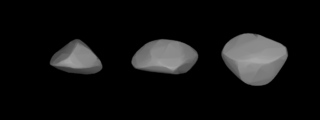Related Research Articles

Endymion is a large Main belt asteroid. It was discovered by Max Wolf on 17 October 1892 in Heidelberg. It was the first asteroid to receive the name of a male god.

Persephone is a main belt asteroid. It was discovered by German astronomer Max Wolf on 23 February 1895 in Heidelberg.

Arachne is a large Main belt asteroid. It is classified as a C-type asteroid and is probably composed of carbonaceous material. It was discovered on 13 October 1895, by German astronomer Max Wolf at Heidelberg Observatory.
Zähringia, provisional designation 1896 CZ, is a stony asteroid from the intermediate asteroid belt, approximately 14 kilometers in diameter. It was discovered on 7 September 1896, by astronomer Max Wolf at Heidelberg Observatory in Germany. The asteroid was named for the House of Zähringen, a medieval noble family that ruled parts of Swabia and Switzerland.
Signe, provisional designation 1900 FM, is a stony asteroid from the background population of the intermediate asteroid belt, approximately 26 kilometers in diameter. It was discovered by German astronomer Max Wolf at Heidelberg-Königstuhl State Observatory on 22 October 1900. The asteroid was presumably named after Signy, a character of the Scandinavian Völsunga saga and Norse mythology. Signy is the daughter of Völsung and sister of Sigmund.
Gismonda is a Themistian asteroid discovered by Max Wolf. Gismonda is named after the daughter of Tancred, prince of Salerno, from Giovanni Boccaccio's work, The Decameron.

Rezia is a minor planet orbiting the Sun. It was discovered by Max Wolf on March 20, 1904. It is named for a character in the 1826 opera Oberon by Carl Maria von Weber. Among the 248 discoveries by Wolf, he also discovered 527 Euryanthe and 529 Preziosa on the same day.
610 Valeska is a minor planet, specifically an asteroid, orbiting primarily in the asteroid belt. Discovered in 1906 by Max Wolf. The origin of the name is unknown, but it may be related to the provisional designation 1906 VK. In Slavic origin, it also means Glorious ruler. Photometric observations provide a rotation period of 4.9047±0.0002 h with a brightness variation of 0.17±0.03 in magnitude.
805 Hormuthia is a minor planet orbiting the Sun. This asteroid follows an elliptical orbit through the main asteroid belt that reaches perihelion just outside the Kirkwood gap at 2.5 AU. Its estimated diameter is 73 km, and it is one of the 500 largest asteroids. 805 Hormuthia was discovered by Max Wolf in 1915, at the University of Heidelberg. The planet is named after Hormuth Kopff, the wife of astronomer August Kopff.

816 Juliana is a minor planet orbiting the Sun. It measures 59.85k in diameter. It was discovered on 8 February 1916 by Max Wolf at the Landessternwarte Heidelberg-Königstuhl Observatory in Heidelberg, Germany.

837 Schwarzschilda, provisional designation 1916 AG, is a low-eccentric, well-observed asteroid from the asteroid belt, orbiting the Sun with a period of 3.48 years at a distance of 2.21–2.39 AU. It was discovered by German astronomer Max Wolf at Heidelberg Observatory on 23 September 1916.
1034 Mozartia, provisional designation 1924 SS, is a stony asteroid from the inner regions of the asteroid belt, approximately 8 kilometers in diameter. It was discovered on 7 September 1924, by Soviet Vladimir Albitsky at Simeiz Observatory on the Crimean peninsula, and named after Wolfgang Amadeus Mozart.
1661 Granule, also designated A916 FA, is a stony Florian asteroid from the inner regions of the asteroid belt, approximately 7 kilometers in diameter. It was discovered on 31 March 1916, by German astronomer Max Wolf at Heidelberg Observatiry in southern Germany, and named for American pathologist Edward Gall.
1713 Bancilhon, provisional designation 1951 SC, is an asteroid from the inner regions of the asteroid belt, approximately 5.7 kilometers in diameter.
1818 Brahms, provisional designation 1939 PE, is an asteroid from the inner regions of the asteroid belt, approximately 6 kilometers in diameter. It was discovered on 15 August 1939, by German astronomer Karl Reinmuth at Heidelberg Observatory in southern Germany. The asteroid was named after composer Johannes Brahms.
1921 Pala, provisional designation 1973 SE is a background asteroid in an unstable orbit located in the outer region of asteroid belt, approximately 8.2 kilometers in diameter. It is one of very few bodies located in the 2 : 1 mean motion resonance with Jupiter. It was discovered by Dutch–American astronomer Tom Gehrels at Palomar Observatory on 20 September 1973.

1637 Swings, provisional designation 1936 QO, is a dark asteroid from the outer region of the asteroid belt, approximately 50 kilometers in diameter. Discovered by Joseph Hunaerts in 1936, it was named after Belgian astronomer Pol Swings.
1944 Günter, provisional designation 1925 RA, is an asteroid from the inner regions of the asteroid belt, approximately 5 kilometers in diameter.
1856 Růžena, provisional designation 1969 TW1, is a stony asteroid from the inner regions of the asteroid belt, approximately 6.6 kilometers in diameter. It was discovered on 8 October 1969, by Russian astronomer Lyudmila Chernykh at Crimean Astrophysical Observatory in Nauchny, on the Crimean peninsula. The asteroid was named after Růžena Petrovicova, staff member at Kleť Observatory.
655 Briseïs is a minor planet orbiting the Sun.
References
- ↑ "642 Clara (1907 ZY)". JPL Small-Body Database . NASA/Jet Propulsion Laboratory . Retrieved 5 May 2016.
- ↑ Schmadel, Lutz D. (2007). "(642) Clara". Dictionary of Minor Planet Names – (642) Clara. Springer Berlin Heidelberg. p. 64. doi:10.1007/978-3-540-29925-7_643. ISBN 978-3-540-00238-3.